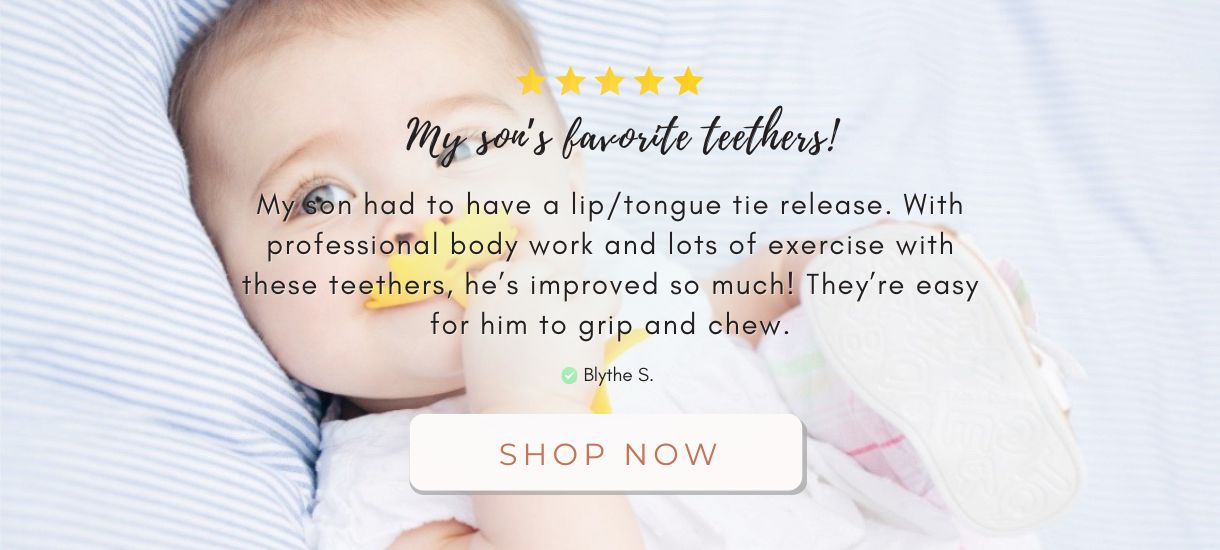Photo: © via canva.com
Does Your Baby Have a Sensitive Gag Reflex?
Now that your baby is starting solids, you’re starting to see them gag a little bit when they eat. This can be terrifying for any parent, but it is an important reflex for your baby to learn so that they can properly eat food. Letting them gag and work through it is hard to see and even harder if it happens all the time. This can mean that your baby has a sensitive gag reflex, making mealtime a less than enjoyable experience for both of you. Luckily, there are things you can do to help. Keep reading to learn more about sensitive gag reflexes, what to do, and the teethers you need to help develop your baby’s oral motor skills.

How Do I Know If My Baby Has a Sensitive Gag Reflex?
Gagging is a natural protective reflex that results in the contraction of the back of the throat to protect us from choking. Just like the reflexive kick that occurs when the doctor taps your knee in just the right spot, the gag happens automatically, initiating a rhythmic bottom-up contraction of your pharynx (the tube that leads to your stomach) to assist in bringing food up and to stop the swallowing reflex from making our bodies try to swallow. (source: Solidstarts.com)
From birth to around 7-9 months, the gag reflex is triggered close to the front of the mouth (around the middle of the tongue). At this age, the gag reflex is as sensitive as it will ever be. Sometime around 7-12 months of age, the gag reflex slowly desensitizes. The gag trigger moves from the middle of the tongue to the back of the tongue towards the throat. (source: Researchgate.net) For some babies, it can take longer for their gag reflex to desensitize, making your baby seem like they are extra prone to gagging.
Gagging vs Choking
When you see your baby gagging, your initial knee-jerk reaction might be to help them and remove whatever food is in their mouth. However, as mentioned, gagging is an important part of learning how to eat and desensitize their reflex. Letting them work through the coughing and learning how to get things out of their throat on their own through gagging is essential for their development. It is important to know the difference between gagging and actual choking so that you know when you should take action.

Gagging:
- Baby is retching
- Coughing
- Crying
- Breathing through coughs
Choking:
- Baby is quiet
- Seems panicked
- Wheezing
- Not breathing
Remember: Gagging on food is totally normal! It actually helps to prevent choking because your little one is learning how to move food toward the front of their tongue. This can be just as important away from the table as it is at the table if your little one were to get anything in their mouth that could potentially choke them.
Tips to Improve Your Baby’s Sensitive Gag Reflex
If your baby seems to have an extra sensitive gag reflex, the best thing you can do is practice, practice, practice! The more your baby gets to know their own mouth, the easier the desensitization process will be. It will be able to move closer to the back of their mouth, and your baby can safely eat without so much gagging.
We also understand that watching your baby gag on food can be stressful. If you wish to practice working on their gag reflex away from the table, we have the perfect exercise for you!
Here’s a step-by-step exercise you can do with your baby to improve their gag reflex that does not involve food.
- First thing’s first: Grab your Innobaby Oral Development Star Teether
- Let your baby explore one little tip of the star teether and see what happens
- If your baby moves with their tongue, try two tips
- Watch your baby explore it and give the entire teether.

Oral Development Teethers
Your baby’s mouth goes through a lot within the first year. Between teething, learning how to eat, learning how to swallow, and much more, there is a lot for their little mouths to learn. It can be just as hard for parents to watch their little one go through pain and struggle, but luckily, there is a way you can jumpstart their oral development with a simple teether!
Innobaby’s star teethers aren’t just great for teething pain; they’re considered “training teethers,” which means they’re great for a bunch of different reasons:
- They stimulate the muscles of the lips, tongue, and cheeks to improve oral motor skills
- They aid in nursing, eating solid foods, drinking from cups, and speech development.
- The light and easy-to-grip handle also improves hand-eye coordination.
- Giving two to baby will allow for bilateral movement and stimulation of both sides of the brain
Innobaby holds its teethers to the very highest standards (Conform to Toy Safety Standard ASTM F963 and EN71) and uses the highest quality TPE available because Innobaby wants the best for your baby, just like you! Other teethers may be too small or break apart easily, but you can trust ours!
These awesome teethers are also top-rack dishwasher safe to make cleaning easy and freezer safe to make them even more interesting for your baby. And, of course, they are BPA-, phthalate-, PVC-, latex-, and lead- free like the rest of our teethers!
For more parenting tips, teething hacks, and safe products for the whole family, visit us at Innobaby.com!



